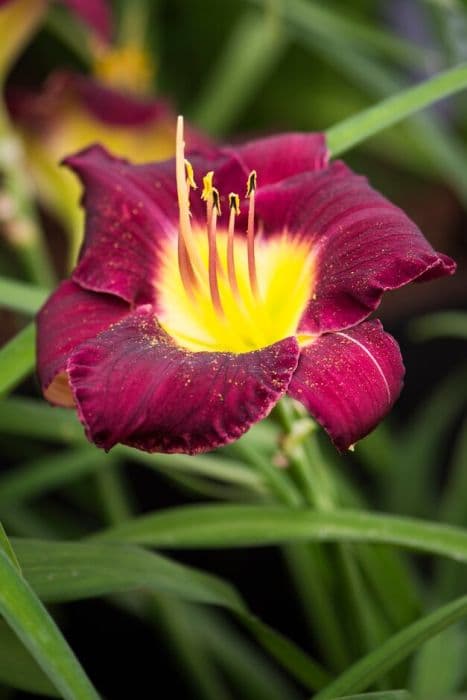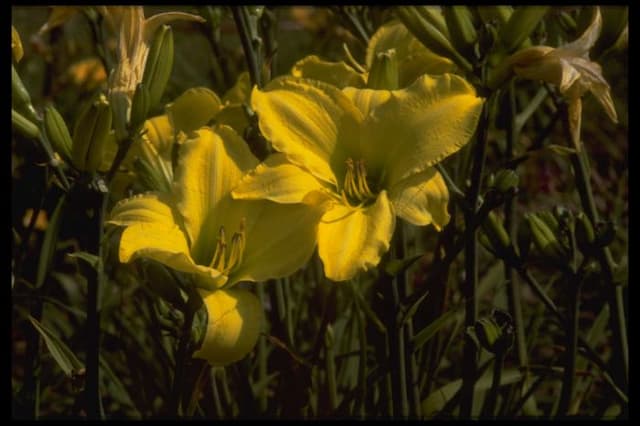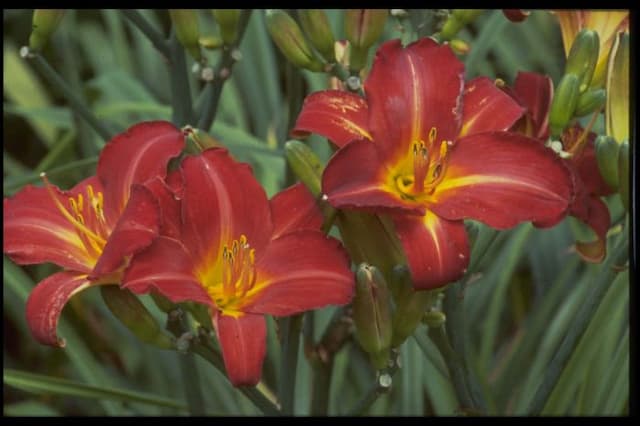Daylily Hemerocallis 'Tetrina's Daughter'

ABOUT
Hemerocallis 'Tetrina's Daughter', often known as the daylily due to its flowers lasting for just one day, is a perennial plant celebrated for its charming blooms. It showcases flowers that have a delightful and captivating trumpet shape, usually presenting a blend of soft and enchanting colors. The petals can exhibit a gradient of hues, often with a gradient from the throat of the blossom to the edges. Each flower consists of six petals that can exhibit ruffled or smooth edges, with the overall look giving off an impression of delicate beauty. These petals surround a contrasting center, which is typically a darker and more saturated color than the petals. This center, known as a throat, adds an eye-catching focus to the flower, drawing the observer’s attention right into the heart of the bloom. The foliage of Hemerocallis 'Tetrina's Daughter' forms a dense clump of long, narrow leaves. These leaves are grass-like in appearance, arching gently from the base of the plant and providing a lush green backdrop that complements the vibrant colors of the flowers. The leaves also contribute to the overall texture of the plant in the garden, making it an appealing choice not just for its flowers, but for its foliage as well. The plant produces multiple flowers on sturdy stems that rise above the foliage, creating a display that adds vertical interest in a garden setting. The arrangement of the flowers along the stems is typically in an open and loose manner, allowing each blossom to be appreciated individually while contributing to the fullness of the plant's blooming display. The overall effect of Hemerocallis 'Tetrina's Daughter' is one of a lively and graceful plant that can capture the hearts of gardeners and flower enthusiasts alike.
About this plant
 Names
NamesFamily
Asphodelaceae
Synonyms
Daylily
Common names
Hemerocallis 'Tetrina's Daughter'.
 Toxicity
ToxicityTo humans
Hemerocallis 'Tetrina's Daughter', commonly known as daylily, is not considered toxic to humans. In fact, many parts of this plant are edible and it is sometimes used in culinary dishes. However, eating daylilies may cause a mild stomach upset in some individuals if they are sensitive or allergic to the plant.
To pets
Daylilies are highly toxic to cats. Ingestion can lead to acute kidney failure in cats, which is potentially life-threatening. Symptoms of poisoning include vomiting, lethargy, loss of appetite, and increased urination followed by a lack of urination as kidney failure progresses. If you suspect your cat has eaten any part of a daylily, immediate veterinary attention is crucial. The plant is not known to be toxic to dogs or other pets, but cautious pet owners may choose to keep all pets away from it to be safe.
 Characteristics
CharacteristicsLife cycle
Perennials
Foliage type
Deciduous
Color of leaves
Green
Flower color
Pink
Height
2 feet (60 cm)
Spread
2 feet (60 cm)
Plant type
Herb
Hardiness zones
3-9
Native area
Asia
Benefits
 General Benefits
General Benefits- Ornamental Value: Hemerocallis 'Tetrina's Daughter', also known as daylily, has attractive blooms that enhance garden aesthetics.
- Drought Tolerance: Once established, daylilies are quite tolerant of drought, reducing the need for frequent watering.
- Low Maintenance: They require minimal care, making them suitable for busy or inexperienced gardeners.
- Pest Resistance: Daylilies are generally resistant to pests, minimizing the need for chemical treatments.
- Rapid Growth: They can grow and multiply quickly, filling up garden spaces and providing more plants for division and sharing.
- Adaptability: Daylilies adapt well to a variety of soil conditions and climates.
- Long Blooming Period: They have a long flowering season, providing color in the garden for an extended time.
- Edibility: Some parts of daylilies are edible, adding a unique flavor to culinary dishes.
- Variety: Daylilies come in a vast array of colors and forms, offering diverse options for garden design.
- Soil Erosion Control: Their dense root system can help stabilize soil and prevent erosion.
 Medical Properties
Medical PropertiesThis plant is not used for medical purposes
 Air-purifying Qualities
Air-purifying QualitiesThis plant is not specifically known for air purifying qualities.
 Other Uses
Other Uses- Daylilies such as 'Tetrina's Daughter' can be used in natural dye production; their petals can create a range of colors on textiles, depending on the mordant used.
- The flowers of the daylily can be added to salads or used as garnish, providing a sweet taste and a splash of color to various dishes.
- Daylily tubers have been used historically as a starchy root vegetable, cooked similarly to potatoes or other root crops.
- The thick roots can help with erosion control on banks or slopes due to their extensive root systems.
- The spent blossoms of daylilies can be used in compost piles to add nutrients and organic matter to garden soil.
- Daylilies can be planted as a living mulch in orchards or food forests to suppress weeds and retain soil moisture.
- In permaculture design, daylilies serve as both an aesthetic and a practical element due to their low maintenance and attractiveness to pollinators.
- Daylily leaves can be used as a fodder for some livestock, such as goats, when other feed sources are scarce.
- The plant can also be used in gray water treatment systems for landscaping irrigation, where they help in filtering impurities.
- Daylilies are used as an educational tool in gardening workshops and schools, demonstrating plant division and propagation techniques.
Interesting Facts
 Feng Shui
Feng ShuiThe Daylily is not used in Feng Shui practice.
 Zodiac Sign Compitability
Zodiac Sign CompitabilityThe Daylily is not used in astrology practice.
 Plant Symbolism
Plant Symbolism- Beauty: The Hemerocallis, commonly known as the Daylily, is often associated with beauty due to its vibrant and attractive flowers.
- Mothers and Daughters: Given the name 'Tetrina's Daughter', this specific variety of Daylily may symbolize the bond between mothers and daughters, representing kinship and continuity.
- Ephemeral Nature of Life: Daylilies typically bloom for just one day, representing the transient nature of life and the importance of cherishing each moment.
- Rebirth and Renewal: Despite their individual flowers lasting only a day, Daylilies are perennials that return each year, which can symbolize rebirth and the renewal of opportunities.
 Water
WaterDaylilies, including 'Tetrina's Daughter', generally need consistent moisture, especially during the growing season. Aim to water your daylilies about once a week with approximately 1 inch of water each time, which is roughly 0.6 gallons for an established plant in a typical garden setting depending on the soil type and climate. They prefer soil that is moist but well-draining. During hot, dry spells, you may need to increase watering frequency to maintain the soil moisture. However, avoid overwatering as this can lead to root rot. During winter or in cooler climates, you can reduce watering since the plants will be dormant and require less moisture.
 Light
LightDaylilies do best in full sunlight, so 'Tetrina's Daughter' should be placed in a spot where it receives at least 6 hours of direct sunlight each day. They can tolerate partial shade, but too much shade can reduce blooms and lead to weaker plants. An ideal spot for 'Tetrina's Daughter' would be a sunny border or an open area of your garden with bright, unfiltered sunlight for the majority of the day.
 Temperature
TemperatureDaylilies are hardy and 'Tetrina's Daughter' can typically withstand temperatures down to about 20 degrees Fahrenheit, but they thrive in temperatures between 60 and 80 degrees Fahrenheit. Extended periods of heat above 90 degrees Fahrenheit can stress the plant, although it can survive these conditions if properly cared for. Ideal growth and flowering occur within this preferred temperature range, ensuring healthy foliage and vibrant blooms.
 Pruning
PruningPruning 'Tetrina's Daughter' daylilies involves removing spent blooms, known as deadheading, and cutting back the foliage after it starts to yellow, usually in late fall. Deadheading can be done throughout the blooming season to encourage more flowers and prevent seed production. Cut back the foliage to a few inches above the ground in late fall or early spring before new growth begins for a tidy appearance and to promote healthy growth.
 Cleaning
CleaningAs needed
 Soil
SoilDaylilies prefer well-drained, mildly acidic to neutral soil, with an ideal pH range of 6.0 to 7.0. A soil mix containing equal parts of loamy soil, peat moss or compost, and coarse sand or perlite would provide the necessary drainage and fertility. Amend with organic matter annually to maintain soil health.
 Repotting
RepottingDaylilies are typically grown in the ground rather than being repotted. Divide clumps every 3-5 years to rejuvenate and prevent overcrowding.
 Humidity & Misting
Humidity & MistingDaylilies are adaptable to various humidity levels and do not require specific humidity conditions for optimal growth; they thrive in the natural outdoor humidity.
 Suitable locations
Suitable locationsIndoor
Ensure bright light and ample space for growth.
Outdoor
Plant in sunny spot, amend soil, water regularly.
Hardiness zone
3-9 USDA
 Life cycle
Life cycleHemerocallis 'Tetrina's Daughter', commonly known as Daylily, begins its life cycle as a seed, which upon germination produces a tiny plantlet. As the roots and foliage develop, it grows into a juvenile plant with strap-like leaves forming a clump. The plant reaches maturity in a few years, with the formation of flower scapes that bear numerous buds. The daylily blooms in early to midsummer, with each flower lasting just one day; after pollination, it can produce seed capsules containing numerous seeds. Once the flowering period is over, the plant enters a period of vegetative growth where it continues to expand its foliage and store energy in its underground rhizomes for the next blooming season. During winter or unfavorable conditions, the daylily goes dormant, with above-ground parts dying back, reemerging when favorable conditions return.
 Propogation
PropogationPropogation time
Late summer
Hemerocallis 'Tetrina's Daughter', commonly known as daylily, is most effectively propagated through division. This perennial plant tends to form dense clumps which can be divided either in early spring or after the flowering period in late summer to early fall. To propagate by division, the gardener should carefully dig around the clump to lift it from the ground without causing too much root damage. Washing the soil off the roots can help in teasing them apart and separating the clump into smaller sections. Each division should have a good portion of the root system and at least a few shoots. These divisions can then be replanted at the same depth they were originally growing, spaced approximately 18 to 24 inches (about 45 to 60 centimeters) apart to allow room for growth. Watering the newly planted divisions thoroughly helps to establish them in their new location.









